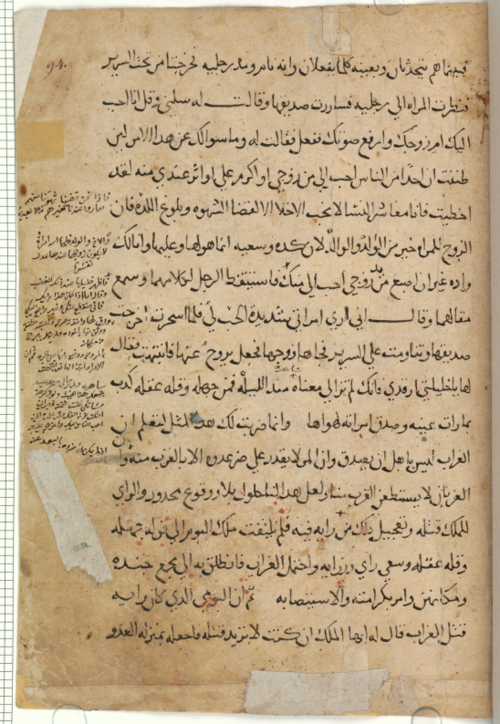Marginal Notes
Rima Redwan
Marginal notes, a common ingredient of Arabic manuscripts, are not frequent in the circa 100 manuscripts of Kalila wa-Dimna so far identified.
Where such notes do appear, they are usually brief and add corrections or short comments. Ample marginal annotation is rare and therefore all the more interesting where it occurs. Such is the case with manuscript Cod. Arab. 616 of the Bayerische Staatsbibliothek, which contains copious marginalia (ḥawāšī, sing. ḥāšiya). It was copied in Egypt in 1310 CE, consists of 129 folios with 17 lines per page, and contains 73 beautifully executed illustrations. The last chapter of ‘The King and His Dreams’ (Īlād wa-Iblād)is missing in the table of contents (fols. 17v-18r) but present in the manuscript (fol. 103r ff.), which also contains the short version of Burzoy’s journey to India (fols. 30r ff.), which is rare among the Arabic versions. Several folios in the middle have been restored in a second hand, and the book’s beginning and end have been restored by in a third hand by a recent scribe.
The special interest of Cod. Arab. 616 are its marginal annotations, written in a very small hand. This fourth hand is similar to the hand of the main text, but certain letters (such as kāf, final nūnand final hāʾ) are traced differently, and the letters’ lower curves are more rounded than in the script of the main text. These marginalia are currently being transcribed and are of particular interest, as they constitute an independent version of the text.
As is occasionally the case, the scribe of the main text of Cod. Arab. 616 manuscript produced a shortened version of the chapter of Owls and Crows (al-būm wa-l-ghirbān). This can be seen by the fact that from among the segments into which the chapter is divided in all manuscripts for comparison, a good number is missing here. We are dealing with an abridgment.
The marginalia, however, address this very issue. There, text appears that supplies either entire missing segments or completes text segments that have been abridged. Some of the formulation is very close to the manuscript London, British Library Arabic 4044 that has been dated to the fifteenth century. However, in three instances on the displayed page (fol. 94r), the scribe of the fourth hand added phrases that have so far not been found otherwise. The marginalia are written carefully next to the line into which they are to be inserted and the insertion points are marked by a symbol (a small circle, cross, or asterisk), which is repeated next to the marginal note to which it belongs.
The most fascinating aspects is these “unique” portions. Here the scribe added dramatic detail to the action, namely a parable about a wive carrying on an affair, while tricking her husband into believing that she only loves him. The new portions give more lines of dialogue to the spurned lover and the credulous loving husband. The scribe adds humor and color to this domestic farce. This entertaining parable is told by a character in the main story for a rather serious purpose, namely to warn the king of the crows about a spy, but here it develops a life of its own. It is also notable that, in the unique portions, colloquial features (e.g., the feminine suffix pronoun -kī,as opposed to classical Arabic -ki) appear with higher frequency.
The linguistic clues support the hypothesis that the scribe first discovered (at least) one other version of the text and added what he found missing on the margin. Then the realization of the text’s fluidity may have incited him to step in and redact the sub-story himself in the way it appears. The copyist thus became a redactor and silent co-author. Further research on the manuscript’s other chapters is needed to test this hypothesis. The appearance of an independent marginal version in a manuscript is a new discovery and so far a singular case in the textual history of Kalila wa-Dimna.
